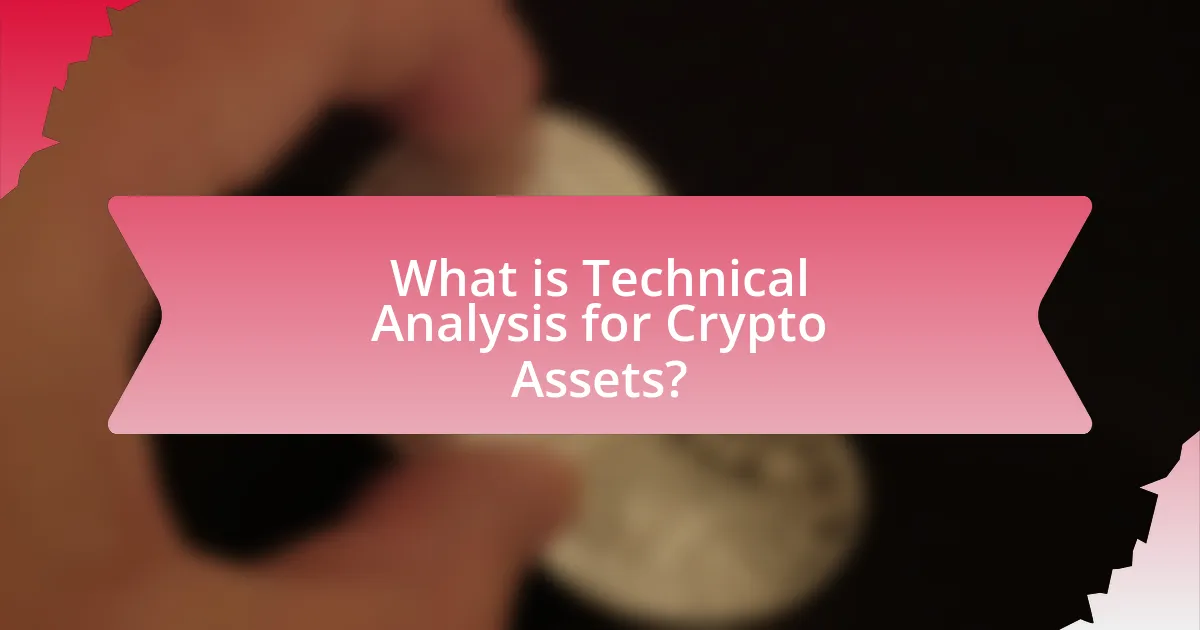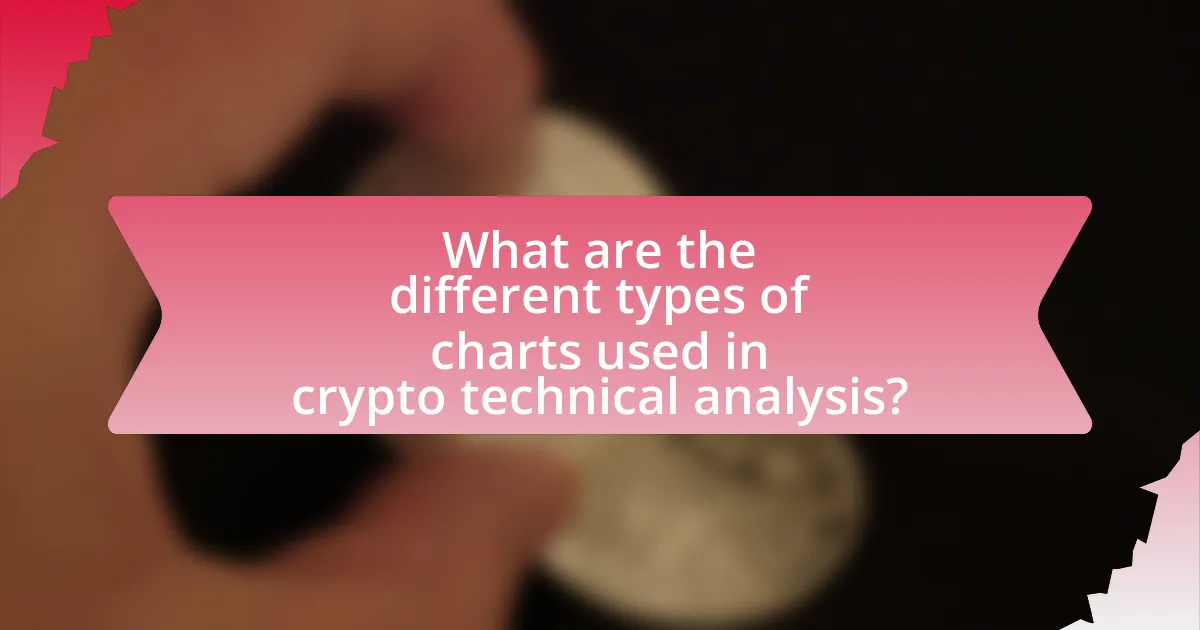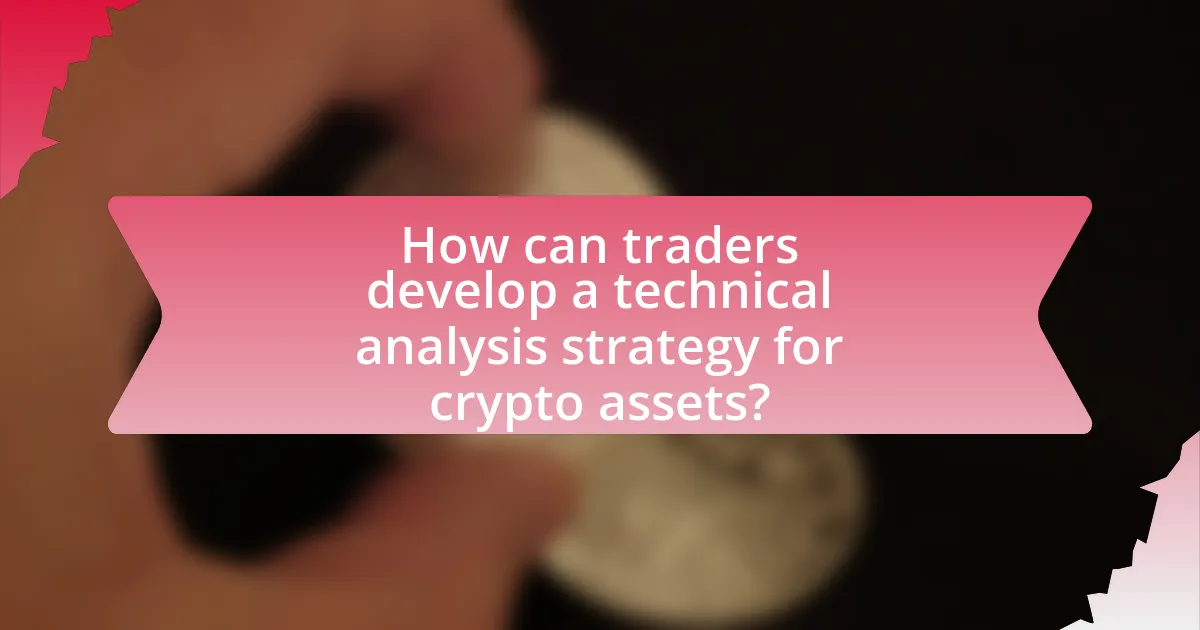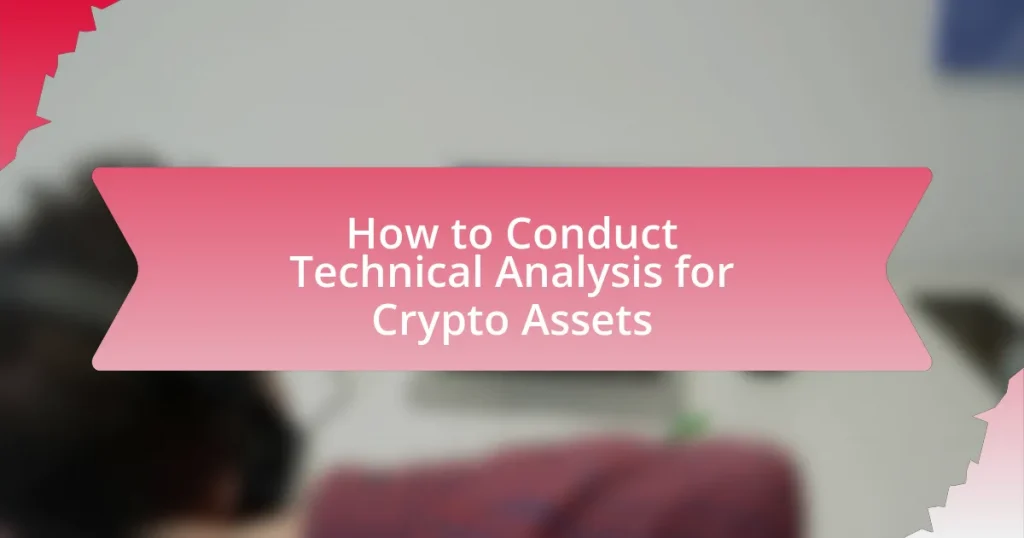Technical analysis for crypto assets is a method used to evaluate and predict future price movements of cryptocurrencies by analyzing historical price data and trading volumes. This article outlines the differences between technical and fundamental analysis, emphasizing key principles such as price action, trends, support and resistance levels, and volume analysis. It discusses the importance of technical analysis for traders, common tools and indicators used, and the significance of various chart types, including candlestick charts. Additionally, the article covers strategies for applying technical analysis effectively, common mistakes to avoid, and best practices for staying updated with market trends and analysis tools.

What is Technical Analysis for Crypto Assets?
Technical analysis for crypto assets is a method used to evaluate and predict the future price movements of cryptocurrencies by analyzing historical price data and trading volumes. This approach relies on various tools and indicators, such as moving averages, relative strength index (RSI), and candlestick patterns, to identify trends and potential entry or exit points for traders. The validity of technical analysis is supported by the observation that price movements often follow patterns due to market psychology and trader behavior, making it a widely adopted strategy in the cryptocurrency market.
How does technical analysis differ from fundamental analysis in crypto?
Technical analysis in crypto focuses on price movements and trading volumes to predict future price trends, while fundamental analysis evaluates the underlying value of a cryptocurrency based on factors like technology, team, market demand, and economic conditions. Technical analysis uses charts and indicators, such as moving averages and RSI, to identify patterns, whereas fundamental analysis examines whitepapers, project roadmaps, and market news to assess a cryptocurrency’s potential. For instance, a technical analyst might look at Bitcoin’s price chart to identify support and resistance levels, while a fundamental analyst would analyze Bitcoin’s adoption rate and regulatory environment to gauge its long-term viability.
What are the key principles of technical analysis?
The key principles of technical analysis include the concepts of price action, trends, support and resistance levels, and volume analysis. Price action refers to the movement of a security’s price over time, which is the primary focus of technical analysis. Trends indicate the general direction of the market, categorized as upward, downward, or sideways, and are essential for making predictions about future price movements. Support and resistance levels are critical price points where the asset tends to reverse direction, with support acting as a floor and resistance as a ceiling. Volume analysis examines the number of shares or contracts traded, providing insight into the strength of a price movement. These principles are foundational for traders to make informed decisions based on historical price data and market behavior.
Why is technical analysis important for crypto traders?
Technical analysis is important for crypto traders because it helps them make informed trading decisions based on historical price movements and market trends. By analyzing price charts, patterns, and indicators, traders can identify potential entry and exit points, assess market sentiment, and manage risk effectively. For instance, studies have shown that traders who utilize technical analysis can achieve higher returns compared to those who rely solely on fundamental analysis, as they can react more swiftly to market changes. This analytical approach is particularly crucial in the highly volatile cryptocurrency market, where price fluctuations can be rapid and significant.
What tools are commonly used in technical analysis for crypto?
Common tools used in technical analysis for crypto include charting software, indicators, and trading platforms. Charting software like TradingView allows users to visualize price movements and patterns. Indicators such as Moving Averages, Relative Strength Index (RSI), and Bollinger Bands help traders assess market trends and potential entry or exit points. Additionally, trading platforms like Binance and Coinbase Pro provide integrated tools for executing trades based on technical analysis. These tools are essential for making informed trading decisions in the volatile cryptocurrency market.
What are the most popular charting tools for crypto analysis?
The most popular charting tools for crypto analysis include TradingView, Coinigy, and CryptoCompare. TradingView is widely recognized for its user-friendly interface and extensive library of technical indicators, making it a favorite among traders. Coinigy offers a comprehensive platform that integrates multiple exchanges, allowing users to analyze and trade cryptocurrencies seamlessly. CryptoCompare provides detailed market data and charting capabilities, enabling users to track price movements and trends effectively. These tools are favored for their robust features and accessibility, which enhance the technical analysis process for crypto assets.
How do indicators and oscillators assist in technical analysis?
Indicators and oscillators assist in technical analysis by providing quantitative measures that help traders identify market trends, momentum, and potential reversal points. These tools, such as moving averages and the Relative Strength Index (RSI), analyze historical price data to generate signals that indicate whether an asset is overbought or oversold. For instance, the RSI ranges from 0 to 100, with values above 70 typically indicating overbought conditions and values below 30 indicating oversold conditions, thus guiding traders in making informed decisions. Additionally, indicators like MACD (Moving Average Convergence Divergence) help in identifying changes in momentum by comparing two moving averages, which can signal potential entry or exit points in a trade.
What are the main concepts of price action in crypto technical analysis?
The main concepts of price action in crypto technical analysis include support and resistance levels, trend identification, candlestick patterns, and volume analysis. Support and resistance levels are critical price points where the market tends to reverse or consolidate, providing traders with insights into potential entry and exit points. Trend identification involves recognizing the direction of price movement, which can be upward, downward, or sideways, helping traders align their strategies with market momentum. Candlestick patterns, such as doji, engulfing, and hammer formations, offer visual cues about market sentiment and potential reversals. Volume analysis complements price action by indicating the strength of price movements; higher volume during a price increase suggests strong buying interest, while low volume may indicate weak momentum. These concepts are foundational for traders seeking to make informed decisions based on historical price movements and market behavior.
How do support and resistance levels influence trading decisions?
Support and resistance levels significantly influence trading decisions by providing critical price points where market sentiment shifts. Traders use these levels to identify potential entry and exit points, as prices often reverse or consolidate at these thresholds. For instance, when a cryptocurrency approaches a support level, traders may view it as a buying opportunity, anticipating a bounce back, while a resistance level may signal a selling opportunity, as prices often struggle to break through. Historical data shows that approximately 70% of price movements occur within these levels, reinforcing their importance in technical analysis.
What role do trends play in technical analysis for crypto assets?
Trends are fundamental in technical analysis for crypto assets as they help traders identify the general direction of price movements. By analyzing historical price data, traders can determine whether an asset is in an uptrend, downtrend, or sideways trend, which informs their trading strategies. For instance, according to a study by the CFA Institute, over 70% of traders rely on trend analysis to make informed decisions, highlighting its significance in predicting future price behavior.
How can one effectively apply technical analysis to crypto trading?
To effectively apply technical analysis to crypto trading, one should utilize chart patterns, indicators, and volume analysis to make informed trading decisions. Chart patterns, such as head and shoulders or triangles, help identify potential price movements, while indicators like Moving Averages and Relative Strength Index (RSI) provide insights into market trends and momentum. Volume analysis further supports these findings by confirming the strength of price movements; for instance, a price increase accompanied by high volume suggests strong buying interest. Historical data shows that traders who incorporate these elements into their strategies can enhance their predictive accuracy, as evidenced by studies indicating that technical analysis can yield better returns compared to random trading.
What are the common mistakes to avoid in crypto technical analysis?
Common mistakes to avoid in crypto technical analysis include over-reliance on indicators, neglecting market context, and failing to manage risk. Over-reliance on indicators can lead to misinterpretation of market signals, as indicators often lag behind price movements. Neglecting market context, such as news events or macroeconomic factors, can result in poor decision-making, as these elements significantly influence price action. Additionally, failing to manage risk through proper stop-loss orders can lead to substantial losses, as the volatile nature of cryptocurrencies can result in rapid price changes. These mistakes are frequently observed among traders, emphasizing the importance of a balanced and informed approach to technical analysis.

What are the different types of charts used in crypto technical analysis?
The different types of charts used in crypto technical analysis include line charts, bar charts, and candlestick charts. Line charts display price movements over time by connecting closing prices with a continuous line, making it easy to identify trends. Bar charts provide more information by showing the open, high, low, and close prices for a specific time period, allowing traders to analyze price volatility. Candlestick charts, which are popular among traders, visually represent price movements with colored “candles” that indicate the open, high, low, and close prices, offering insights into market sentiment and potential reversals. Each chart type serves a unique purpose in analyzing price action and making informed trading decisions.
How do candlestick charts provide insights into market behavior?
Candlestick charts provide insights into market behavior by visually representing price movements over specific time intervals, allowing traders to identify trends, reversals, and market sentiment. Each candlestick displays the open, high, low, and close prices, which helps traders analyze the strength of price movements. For instance, a series of bullish candlesticks indicates upward momentum, while bearish candlesticks suggest downward pressure. Historical data shows that patterns such as doji, hammer, and engulfing can signal potential market reversals, enhancing decision-making in trading strategies.
What patterns can be identified in candlestick charts?
Candlestick charts reveal several identifiable patterns that traders use for technical analysis. Common patterns include the Doji, which indicates market indecision; the Hammer, suggesting a potential reversal after a downtrend; and the Engulfing pattern, signaling a possible trend reversal when a larger candle completely engulfs a smaller one. These patterns are significant because they provide insights into market sentiment and potential price movements, allowing traders to make informed decisions. For instance, the Hammer pattern has historically been associated with bullish reversals, while the Engulfing pattern has been documented in various market analyses as a reliable indicator of trend changes.
How do line charts differ from bar charts in analysis?
Line charts differ from bar charts in analysis primarily in the way they represent data over time. Line charts display continuous data points connected by lines, making them ideal for showing trends and changes over a period, while bar charts use rectangular bars to represent discrete data points, which is effective for comparing quantities across different categories. For instance, in technical analysis for crypto assets, line charts can illustrate price movements and trends over time, allowing analysts to identify patterns, whereas bar charts can effectively compare trading volumes or price changes between different cryptocurrencies at specific intervals. This distinction is crucial for analysts to choose the appropriate chart type based on the data they wish to convey and the insights they aim to derive.
What is the significance of volume in technical analysis?
Volume is significant in technical analysis as it indicates the strength or weakness of a price movement. High volume during a price increase suggests strong buying interest, while high volume during a price decrease indicates strong selling pressure. For instance, according to a study by the University of California, Berkeley, price movements accompanied by high volume are more likely to be sustained, as they reflect broader market participation. Conversely, low volume can signal a lack of conviction in price changes, making trends more susceptible to reversal. Thus, volume serves as a crucial indicator for traders to assess market sentiment and validate price trends in the context of crypto assets.
How does volume confirm price trends in crypto assets?
Volume confirms price trends in crypto assets by indicating the strength or weakness of a price movement. When price increases are accompanied by high trading volume, it suggests strong buyer interest and validates the upward trend. Conversely, if price rises occur with low volume, it may indicate a lack of conviction among buyers, potentially signaling a reversal. Historical data supports this; for instance, during the 2017 Bitcoin bull run, significant price increases were consistently matched by spikes in trading volume, reinforcing the trend’s legitimacy. Thus, volume serves as a critical indicator in technical analysis, helping traders assess the sustainability of price movements in the crypto market.
What are the implications of low versus high trading volume?
Low trading volume typically indicates a lack of interest or participation in a market, which can lead to increased volatility and difficulty in executing trades at desired prices. In contrast, high trading volume signifies strong market interest and liquidity, allowing for smoother transactions and more stable price movements. For example, during periods of high trading volume, price changes tend to be more gradual and predictable, while low volume can result in sharp price swings due to fewer participants. Historical data shows that assets with consistently high trading volumes often exhibit lower volatility, making them more attractive for investors seeking stability.

How can traders develop a technical analysis strategy for crypto assets?
Traders can develop a technical analysis strategy for crypto assets by identifying key indicators, analyzing price charts, and implementing risk management techniques. First, traders should select relevant technical indicators such as moving averages, Relative Strength Index (RSI), and Bollinger Bands to gauge market trends and momentum. For instance, moving averages can help identify the direction of the trend, while RSI can indicate overbought or oversold conditions.
Next, traders must analyze historical price charts to recognize patterns and support/resistance levels, which can provide insights into potential future price movements. For example, identifying a head and shoulders pattern may signal a trend reversal.
Finally, effective risk management is crucial; traders should set stop-loss orders and position sizes based on their risk tolerance to protect their capital. According to a study by the CFA Institute, incorporating risk management into trading strategies significantly improves long-term profitability. By combining these elements, traders can create a robust technical analysis strategy tailored to the volatile nature of crypto assets.
What factors should be considered when creating a trading plan?
When creating a trading plan, key factors to consider include risk management, market analysis, trading strategy, and performance evaluation. Risk management involves setting stop-loss orders and determining position sizes to protect capital. Market analysis requires understanding technical indicators, chart patterns, and market trends to make informed decisions. A trading strategy outlines entry and exit points, as well as the criteria for executing trades. Performance evaluation involves regularly reviewing trades to assess effectiveness and make necessary adjustments. These factors are essential for developing a structured approach to trading that can enhance profitability and reduce losses.
How can risk management be integrated into a technical analysis strategy?
Risk management can be integrated into a technical analysis strategy by establishing clear risk-reward ratios and setting stop-loss orders based on technical indicators. This approach allows traders to define their maximum acceptable loss before entering a trade, ensuring that potential losses are limited while allowing for profitable opportunities. For instance, a common practice is to set a stop-loss order at a level that corresponds to a recent support level identified through technical analysis, which can help protect against significant downturns. Additionally, using position sizing techniques based on the trader’s overall capital and risk tolerance further enhances risk management, allowing for a balanced approach to trading in volatile markets like cryptocurrencies.
What role does backtesting play in refining trading strategies?
Backtesting plays a crucial role in refining trading strategies by allowing traders to evaluate the effectiveness of their strategies using historical data. This process enables traders to simulate trades based on past market conditions, providing insights into potential performance and risk management. For instance, a study by the CFA Institute found that backtesting can improve strategy performance by identifying weaknesses and optimizing parameters, leading to more informed decision-making. By analyzing the results of backtesting, traders can adjust their strategies to enhance profitability and reduce losses, thereby increasing their chances of success in live trading environments.
What are some best practices for conducting technical analysis in crypto?
Best practices for conducting technical analysis in crypto include using multiple time frames, applying various indicators, and maintaining a disciplined approach to risk management. Analyzing multiple time frames allows traders to identify trends and reversals more effectively, as shorter time frames can provide entry and exit points while longer time frames reveal the overall market direction. Utilizing a combination of indicators, such as moving averages, Relative Strength Index (RSI), and Bollinger Bands, enhances the accuracy of predictions by confirming signals and reducing false positives. Furthermore, implementing strict risk management strategies, such as setting stop-loss orders and defining position sizes, helps protect capital and manage potential losses, which is crucial in the highly volatile crypto market.
How can traders stay updated with market trends and analysis tools?
Traders can stay updated with market trends and analysis tools by utilizing real-time data feeds, subscribing to financial news platforms, and employing technical analysis software. Real-time data feeds provide immediate access to price changes and market movements, which is crucial for making informed trading decisions. Financial news platforms, such as Bloomberg and Reuters, offer insights and updates on market conditions, economic indicators, and geopolitical events that can impact asset prices. Additionally, technical analysis software, like TradingView or MetaTrader, allows traders to analyze historical price data, identify trends, and apply various indicators to forecast future price movements. These resources collectively enhance a trader’s ability to respond swiftly to market changes and make data-driven decisions.















